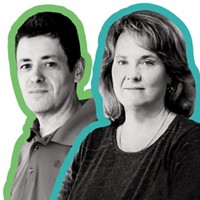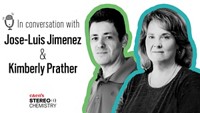Advertisement
Grab your lab coat. Let's get started
Welcome!
Welcome!
Create an account below to get 6 C&EN articles per month, receive newsletters and more - all free.
It seems this is your first time logging in online. Please enter the following information to continue.
As an ACS member you automatically get access to this site. All we need is few more details to create your reading experience.
Not you? Sign in with a different account.
Not you? Sign in with a different account.
ERROR 1
ERROR 1
ERROR 2
ERROR 2
ERROR 2
ERROR 2
ERROR 2
Password and Confirm password must match.
If you have an ACS member number, please enter it here so we can link this account to your membership. (optional)
ERROR 2
ACS values your privacy. By submitting your information, you are gaining access to C&EN and subscribing to our weekly newsletter. We use the information you provide to make your reading experience better, and we will never sell your data to third party members.
Infectious disease
Movers And Shakers
Aerosol expert Jose-Luis Jimenez is sounding the alarm about airborne transmission of COVID-19
The University of Colorado chemist is communicating directly with the public about how people can protect themselves
by Carmen Drahl, special to C&EN
January 2, 2021
| A version of this story appeared in
Volume 99, Issue 1

An academic researcher’s frenetic life sounds relaxing to Jose-Luis Jimenez these days. Since March, the analytical and atmospheric chemist at the University of Colorado Boulder has worked nonstop, urging the US Centers for Disease Control and the World Health Organization to acknowledge that airborne aerosols play an important role in transmitting COVID-19. He’s one of 239 experts in multiple scientific fields who in July signed an open letter to the agencies (Clin. Infect. Dis. 2020, DOI: 10.1093/cid/ciaa939). The CDC has since updated its stance, stating that inhalation is the main mode of transmission of the novel coronavirus, which causes COVID-19. As of C&EN’s deadline, the WHO’s guidance still suggests a minor role for aerosols.
To Jimenez, the CDC’s update was a long time coming, and the WHO’s position is a start but not enough. So he has gone directly to the public, explaining in interviews and written opinion pieces in English and Spanish how people can protect themselves. So many people have asked him for advice on social media that he and his collaborators created a public Google Doc with frequently asked questions.
Carmen Drahl squeezed into an empty spot on Jimenez’s packed calendar to ask about aerosol chemistry, COVID-19, and being a reluctant interviewee. This interview has been edited for length and clarity.
Vitals
Hometown: Zaragoza, Spain
Education: BS-MS, mechanical engineering, University of Zaragoza and University of Technology of Compiègne, 1993; PhD, mechanical engineering, Massachusetts Institute of Technology, 1999; postdoc, Aerodyne Research, 1999–2000, and California Institute of Technology, 2000–2002
Best analogy for aerosol transmission: Breathing in cigarette smoke that builds up in a room. Before smoking in restaurants was forbidden, in Spain you would enter a restaurant and there was a cloud. The limitation of the analogy is that a room where people were smoking will stink the next day or even the next month, but by then the virus is gone.
Health must-have: I used to have a backache and gained weight when I was an assistant professor. I discovered treadmill desks in 2012. The backache went away, and I lost a lot of weight. Often, I’m walking 6 h a day.
Toughest audience to reach: It was only when my Time magazine and El Pais newspaper op-eds appeared that my family finally took me seriously. Since then, most of my family follows my advice—except my mom. I think the WHO will accept that aerosol transmission is major before my mom wears a mask.
What defines an aerosol versus a droplet, and what difference does it make for infection?
From the point of view of infectious disease transmission, an aerosol is a particle of saliva or respiratory fluid that floats in the air and that infects us when we breathe it in. That’s different from a droplet, which is a projectile that infects by hitting us on the eyes, nostrils, or mouth. People generate particles of many sizes when they cough, talk, or sing. When we talk, particles above about 300 µm are droplets because they have enough inertia to do this projectile-like ballistic impaction. When coughing or sneezing we exhale more forcefully, so smaller particles may act like droplets, and in those situations 100 µm may be a better threshold. Particles larger than that can impact like a droplet. At 100 µm in diameter and below, the particles are aerosols and they can only infect by inhalation.
You usually investigate aerosols in Earth’s atmosphere. How did you become part of a COVID-19 project?
I was worried, like everyone else. I saw that COVID-19 wasn’t being controlled. I saw it was arriving in Spain, where I’m from. When I was telling my family to wear masks early on, they thought I was crazy. They seemed to think, “What do you know? You’re an atmospheric chemist.”
In parallel, I was talking to other scientists. I started talking to Linsey Marr at Virginia Tech, with whom I’ve worked on pollution but who I knew was also working on aerosol transmission of viruses. I asked her, “Do you think COVID-19 could be transmitted through the air?” She said, “Yes, I think so.”
Then, on March 28, the WHO posted a graphic to its official accounts on social media saying, “#COVID-19 is NOT airborne” and “Help stop misinformation.” On March 31, Lidia Morawska at Queensland University of Technology wrote to me and asked if I wanted to join a group of scientists she was leading to appeal to the WHO about the importance of airborne spread. So I said, “Yes, of course.” And then I started learning much faster, because this group has many of the world leaders in aerosol transmission of disease.
What did you have to learn? How does studying atmospheric aerosols differ from studying human-generated aerosols?
The aerosol part is very much the same. How they behave in the air, all the tools we use to study them, and the mathematical models that we use—those are the same. The part I didn’t know is the infection part. How many viruses are inside the aerosol? How do they infect? How long will they survive in aerosols? That’s hard to learn on your own. Basically, I’ve done a master’s—on steroids—through this group. We’ve had hours of discussions about every question that comes up. I wouldn’t say I’m an expert in the infection part, but I’m knowledgeable enough.

What other chemistry knowledge is valuable for understanding COVID-19 transmission?
Understanding atmospheric chemistry, including gases and aerosols, is extremely useful. Once you accept that the virus is in the air, you can use this science to ask what would happen in a certain situation. Understanding how these aerosols gain or lose water, how exposure to oxidants or ultraviolet light may damage the virus’s molecules and make it noninfective, is all very useful. We have written mathematical models of how aerosols containing the virus behave in a room.
How are you adjusting to doing constant science communication alongside your research?
It’s a pain. I’m an introvert. I am not someone who seeks the limelight or enjoys being so public. But I feel it’s a civic duty. I am convinced that this disease is transmitted mostly through aerosols and that governments and the WHO are not giving people the tools or the explanations they need to protect themselves.
How do you envision the future of your research, postpandemic? Is its direction forever shifted?
I have to see how useful we would be. There are many good researchers already in the field of airborne disease transmission. I think my group has found some areas of modeling of aerosol transmission in shared room air (Indoor Air 2020, DOI: 10.1111/ina.12751) and the use of carbon dioxide as an indicator of infection risk (medRxiv 2020, DOI: 10.1101/2020.09.09.20191676) where we have already contributed. If we can get funding, some fraction of our activity may be in transmission of diseases.
I will definitely continue studying the atmosphere because—crazy as this may sound now—climate change is a bigger problem than COVID-19.
COVID-19 will pass. Climate change will get worse and be with us forever.

Carmen Drahl is a freelance writer based in Washington, DC, who covers the chemistry-biology interface. A version of this story appeared in ACS Central Science: cenm.ag/jimenez.





Join the conversation
Contact the reporter
Submit a Letter to the Editor for publication
Engage with us on Twitter